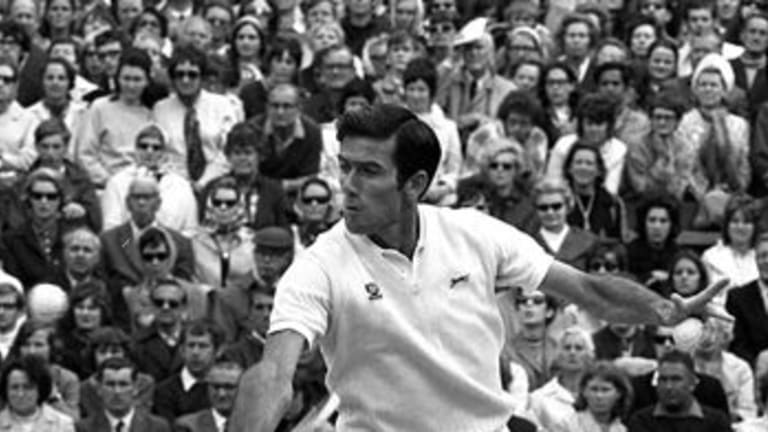—The very first rally proves Flink’s point. Rosewall starts with a delicate backhand return that dips over the net, moves Roche back with a backhand lob, then hits two good backhand volleys before finishing the point with a forehand volley winner. I thought for a second that Rosewall was about to fist-pump after that shot, but that was my modern mind talking. That obviously wasn’t the Muscles way.
—It’s hard to believe Roche is the same gray eminence that you see at tournaments today. He was a lumberer back then, with a heavy serve and a backhand volley he seemingly couldn’t miss—Flink rated it second all time behind Stefan Edberg’s. Roche is using an aluminum racquet, either a Slazenger Smasher or a Chemold, from what I can tell. It gives his shots a distinctive thud, but the way he makes contact they might have sounded like that with wood, too. Roche had lost the Open final to Rod Laver the year before in four sets (that was Laver’s Slam-clinching win), and he goes down in four to Rosewall again here.
—In historical discussions, Rosewall has been understandably, but still unfairly, overshadowed by Laver. His credentials are solid, and his longevity is unique. He won eight majors, four before turning pro in 1956 and four from 1968 on, when the Open era began. We like to imagine how many Slams Laver would have won if he hadn’t been banned from them for five years. But how many would Rosewall have won if he hadn’t been exiled for 11? As it is, he won the very first Open major, the ’68 French Open (over Laver), won four Slams after the age of 33, and is still the oldest men's major winner. He was 37 when he won his last, at the ’72 Aussie Open. He was 39 when he reached the Wimbledon and U.S. Open finals two years later.
Rosewall was also productive in his wilderness years. He won 15 “professional majors,” at the U.S. Pro, the Wembley Pro, and the French Pro.
—At about the 3:35 mark on this tape, Rosewall hits a crosscourt forehand pass winner; he controls it so beautifully that it looks like it has a string attached to it. His game was simple and artistic at once. From the serve on, there’s nothing extraneous in his play or his manner. One of his great early admirers was the stylish French legend René Lacoste. Here’s journalist Al Laney’s description of watching Rosewall with Lacoste at the Orange Lawn Tennis Club in the early 1950s. One artist admires another’s work.
“With my back to the court,” Laney wrote, “I saw Lacoste’s face light up as though a switch had been turned on. I turned around and there was Rosewall hitting balls back and forth with Dick Savitt. René sat up straight and I moved my chair out of his line of vision. I had supposed it was the chance to see Savitt, who had been Wimbledon champion, that interested him. When I spoke of Savitt, however, referring to him as the best amateur player in the world, Lacoste said, “No, it is the little one. A beautiful player. And so young!”
Savitt won that day, but Lacoste stuck with his prediction. “I think he could beat [Savitt] now,” he said of Rosewall, “if he only knew how good he is. Never mind. He will find out.”
With this video, we get an idea of just how good the "little one" became.
